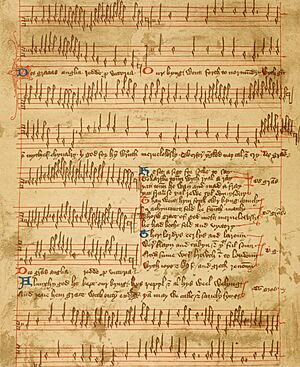Agincourt Carol facts for kids

The Agincourt Carol is a famous English song from the early 1400s. It is sometimes called the Agincourt Song or Agincourt Hymn. The song celebrates the important Battle of Agincourt in 1415. In this battle, the English army, led by Henry V of England, won a big victory. They defeated the French army of King Charles VI in what is now France. The carol's main message is "Deo gratias Anglia", which means "Thanks to God, England".
Contents
What is a Carol?
You might think of carols as songs sung at Christmas. But a carol in the 1400s was a bit different. It was a popular song, often with a religious theme. Carols usually had verses (strophes) and a repeating chorus (burden). The Agincourt Carol follows this old style. It has verses in English and a chorus in Latin.
The Story Behind the Song
The Agincourt Carol tells the story of the Battle of Agincourt. This battle was a major event in the Hundred Years' War. King Henry V of England led his soldiers to France.
The Siege of Harfleur
Before the main battle, the English army first attacked the town of Harfleur. This was a difficult siege. But King Henry V and his men won the town. This victory was a big step for the English.
The Battle of Agincourt
After Harfleur, the English army marched towards Agincourt. Here, they faced a much larger French army. Even though they were outnumbered, the English fought bravely. With great skill and a bit of luck, they won a huge victory. Many French lords and nobles were captured or killed. This battle made King Henry V a hero in England.
Where Did We Find It?
The Agincourt Carol is very old, but we still have copies of it today.
The Trinity Carol Roll
One of the main places we found this song is the Trinity Carol Roll. This is a very old scroll with thirteen carols written on it. It was probably made in a part of England called East Anglia. This scroll is now kept safely in the Wren Library at Trinity College, Cambridge.
The Selden Carol Book
Another important source for the carol is the Selden Carol Book. This book is also from the same time period. It is kept at the Bodleian Library in Oxford. These old documents help us know what the song sounded like hundreds of years ago.
The Song's Words
The carol's chorus is in Latin:
- Deo gratias Anglia redde pro victoria!
- (Give thanks, England, to God for victory!)
Here are some of the verses, telling the story:
- Our King went forth to Normandy
- With grace and might of chivalry
- There God for him worked marvelously;
- Therefore England may call and cry
Chorus Deo gratias! Deo gratias Anglia redde pro victoria!
- He set siege, for truth to say,
- To Harfleur town with royal array;
- That town he won and made a fray
- That France shall rue till doomsday.
Chorus
- Then went him forth, our king comely,
- In Agincourt field he fought manly;
- Through grace of God most marvelously,
- He had both field and victory.
Chorus
- There lords, earls and barons
- Were slain and taken and that full soon,
- And some were brought into London
- With joy and bliss and great renown.
Chorus
- Almighty God he keep our king,
- His people, and all his well-willing,
- And give them grace without ending;
- Then may we call and safely sing:
Chorus
The Carol in Modern Times
The Agincourt Carol is still famous today. It was used in the 1944 film Henry V, directed by Laurence Olivier. This helped many people learn about the song. A composer named Ernest Farrar even used the carol to inspire his music in 1918.


